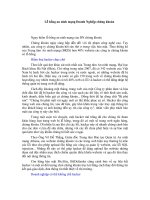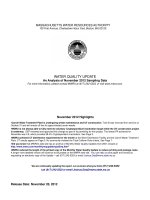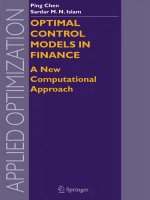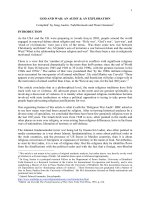An Audit Quality Control System: Essential Elements pdf
Bạn đang xem bản rút gọn của tài liệu. Xem và tải ngay bản đầy đủ của tài liệu tại đây (214.31 KB, 53 trang )
United States General Accounting Office
GAO
Office of Policy
August 1993
An Audit Quality
Control System:
Essential Elements
GAO/OP-4.1.6
Preface
Government audits, evaluations, and investigations
assess the efficiency, effectiveness, and
accountability of government agencies and their
programs. These assignments provide information,
unbiased analysis, and recommendations that the
organization’s customers and stakeholders use to
make informed decisions.
This guide is intended to reinforce the Government
Auditing Standards on quality control; to provide
helpful hints for use by federal, state, and local audit
organizations in designing or improving their systems;
and to ensure consistent quality products that can be
relied on by the organizations’ customers and
stakeholders.
This guide describes the approaches presently being
used by GAO. While the General Policies/Procedures
Manual and the Communications Manual provide
guidance on the various facets of doing our work, this
guide pulls together in one place the essential
elements of GAO’s quality control system.
Today’s total quality management environment offers
excellent opportunities to reassess and continue to
improve the quality control system that helps to
provide customers and stakeholders the service to
which they are entitled.
Key questions that should be considered in assessing
an audit organization’s quality control systems
effectiveness include the following. Are we:
• Doing the right jobs?
• Doing the jobs right?
• Getting results?
• Achieving consistent quality?
GAO/OP-4.1.6Page 1
Preface
These questions are pertinent regardless of the audit
organization’s role, mission, size, or constituency. A
good system should also provide the audit
organization with performance indicators and
feedback from its customers, attesting to the
consistency of quality work.
Werner Grosshans
Assistant Comptroller General
for Policy
GAO/OP-4.1.6Page 2
GAO/OP-4.1.6Page 3
Contents
Preface
1
Chapter 1
Overview
6
The Need for an Appropriate Quality System 6
The Importance of Audit Quality 6
Involvement of Top Management 7
Communicating System Guidance 8
Purpose of This Guide 8
Key Questions 9
Chapter 2
Doing the Right
Job
12
Purpose 12
What Are the Right Jobs? 12
Key Factors in Planning 12
The GAO Example 18
Chapter 3
Doing the Right
Job
20
Purpose 20
Job Design 20
Job Staffing 24
Effective Implementation 24
Product Preparation 27
Chapter 4
Getting Results
31
Purpose 31
High-Quality Recommendations 31
Commitment 32
Monitoring and Followup Systems 32
Special Attention to Key Recommendations 33
Chapter 5
Demonstrating
Consistent
Quality
35
Purpose 35
Internal Quality Reviews 35
Peer Review 38
GAO/OP-4.1.6Page 4
Contents
Appendixes
Appendix I: Listing of GAO’s Technical
Guidance Publications (Gray Books)
40
Appendix II: Doing the Right Job—The GAO
Example
44
Figure
Figure 1.1 10
Abbreviations
AICPA American Institute of Certified Public
Accountants
CM Communications Manual
GPPM General Policies/Procedures Manual
IIA Institute of Internal Auditors
NALGA National Association of Local
Government Auditors
NSAA National State Auditors Association
OIGs Offices of the Inspector General
PCIE President’s Council on Integrity and
Efficiency
GAO/OP-4.1.6Page 5
Chapter 1
Overview
The Need for an
Appropriate
Quality System
Government Auditing Standards require each
organization to have an appropriate quality system in
place. The quality assurance system should provide
reasonable assurance that the organization (1) is
following applicable Government Auditing Standards
and (2) has established and is following appropriate
policies and procedures.
The Government Auditing Standards quality control
standard, the fourth general standard, states:
“Audit organizations conducting government audits should have an
appropriate quality control system in place and participate in an
external quality control review program.”
The Importance
of Audit
1
Quality
A high-quality job greatly increases the probability
that audit results will be relied on and recommended
improvements will be seriously considered and
implemented. The organization’s reputation for
consistent high-quality work helps ensure that
decisionmakers will more readily and more assuredly
accept findings and implement recommendations.
Reputations are built over time by producing
consistent, high-quality work. A hard-earned
reputation is on the line with each product.
To maintain and continue to build excellence requires
total commitment on the part of every member of the
team and the organization.
Challenges to findings and recommendations can be
expected. As an organization increasingly deals with
tougher and more sensitive issues, challenges to its
work increase.
1
This guide uses the word “audit” to include audits, evaluations,
inspections, and investigations. It uses the words “auditor” or
“staff” to include the range of skills and disciplines employed in
such work.
GAO/OP-4.1.6Page 6
Chapter 1
Overview
It is not unusual for various constituencies to believe
that they would be better off if results could be
disproved or called into serious question. A
successful challenge demonstrating minor errors or
inconsistencies may call into question the quality of
work supporting the principal finding or
recommendation.
Regardless of the reason for the challenge, it can be
successfully refuted by demonstrating that findings,
conclusions, and recommendations are warranted
and supported.
An effective quality control system is the basis for
ensuring that the results will meet customers’ needs
time after time and withstand challenges directed at
them.
Involvement of
Top Management
The quality control system should be rooted in top
management’s expectation of and insistence on
quality and the principles, policies, and procedures by
which it can be achieved and will be evaluated.
For example, the following establishes basic goals
and expectations that are a sound basis for GAO’s
quality planning and performance:
“We seek to achieve honest, efficient management and full
accountability in government programs and operations. We serve
the public interest by providing policymakers with accurate
information, unbiased analysis, and objective recommendations on
how best to use public resources in support of the security and
well-being of the American people.
“Commitment to quality is the single most important principle
governing our work.”
The Comptroller General and other top GAO
managers participate in the early direction of work to
GAO/OP-4.1.6Page 7
Chapter 1
Overview
be done and in major decisions at key points in
assignment planning and performance.
Communicating
System Guidance
The quality control system should define principles,
policies, and procedures that will achieve the
consistent quality of work that the organization
expects.
System guidance should establish what is expected at
each phase of an assignment, leaving room for
initiative and creativity on how it is done.
It should be readily available to staff at all levels. For
example, GAO maintains the General
Policies/Procedures Manual (GPPM) and the
Communications Manual (CM) to give guidance on
achieving audit quality. Each chapter has a succinct
policy summary, followed by procedures to be used in
complying with the stated policies.
In addition, GAO publishes more detailed guidance on
technical subjects. Technical guidance publications
are normally referred to as “Gray Books.” A list of
these appears in appendix I.
GAO’s guidance material is accessible either in hard
copy or in electronic mode.
Purpose of This
Guide
An assignment can go wrong at any stage. It can be
ill-conceived, improperly directed, poorly planned,
badly implemented, and its results can be
ineffectively communicated. For a variety of reasons,
it can fail to meet its customers’ needs.
An appropriate quality control system identifies or
flags those factors that could jeopardize the quality of
an audit and establishes processes or procedures that
GAO/OP-4.1.6Page 8
Chapter 1
Overview
promptly identify and correct problems before they
occur. For example, faulty assignment design could
be detected during referencing or in a report review
stage, but that is far too late to deal effectively with
the problem. At that point, little more can be done
than to write around the problem, salvaging what is at
best a bad situation. To be most effective and to
reduce assignment cost, design flaws must be
detected in the assignment planning phase or early in
the data collection and analysis phase to allow for
appropriate intervention and redirection.
The purpose of this guide is to provide helpful hints
for use by federal, state, and local audit organizations
in designing their systems to ensure consistent quality
products that can be relied on by customers and
stakeholders.
It raises key questions that managers and staff should
be able to answer at key stages of the assignment.
Key Questions
Figure 1.1 illustrates key questions that an
appropriate quality control system should address
and the remainder of this guide’s chapters attempt to
address these key questions.
GAO/OP-4.1.6Page 9
Chapter 1
Overview
Figure 1.1
• Selecting those jobs that will make a
contribution—doing the right job. Each job requires
resources that could have been used on another job.
Most audit organizations have “must do” jobs. They
also have considerable latitude in using the rest of
their resources to seek a balanced portfolio—based
on needs, capability, and resources. In exercising that
latitude, staff should be able to answer questions such
as: Is the job selection a wise one? Does it respond
GAO/OP-4.1.6Page 10
Chapter 1
Overview
appropriately to a request or to user needs? Does the
job help build staff capability? Are the benefits of the
job greater than could have been obtained if other
work were done? How do you know? (See ch. 2.)
• Ensuring the quality of each assignment—doing the
job right. Doing a job right requires efficient use of
resources and high effectiveness. Key questions
include the following: Are assignment objectives clear
and responsive to customer needs? Is the assignment
scoped to meet objectives? Is the methodology
appropriate? Is job planning adequate? Are staff
motivated and well-supervised? Are assignment
results effectively communicated? (See ch. 3.)
• Accomplishing intended results. Audit work is
performed for a wide variety of reasons—to
accomplish a range of objectives. Most jobs seek
results that improve the auditee’s operation. The right
job done the right way provides the best opportunity
to get desired results—the bottom line for the auditor
and the audit organization. Were the results of our
work used? Did we have a beneficial impact? Did we
make the difference our work sought? If staff can
answer those questions positively, they are providing
the quality service that stakeholders can expect every
time. (See ch. 4.)
• Demonstrating consistent quality. Care is taken to
build quality into job selection, planning,
performance, reporting, and followup. Individual jobs
are given a final quality check before they go out the
door. But how well have all those policies,
procedures, and processes actually worked? Are you
satisfied that they were followed, fit together, and
accomplished intended results? Can we satisfy peers
that the organization’s work is of high quality, meeting
applicable professional standards? (See ch. 5.)
GAO/OP-4.1.6Page 11
Chapter 2
Doing the Right Job
Purpose
To do the right job requires planning—long range and
day to day.
This chapter gives guidance for developing a planning
system that should be in place to help an organization
determine what jobs should be done immediately and
what jobs should be done in the future. It should
show how the mosaic fits together to achieve
longer-range objectives.
What Are the
Right Jobs?
There is no shortage of good jobs. But with limited
resources, each job that is done prevents another
from being done. Good jobs should give way to better
ones.
Audit organizations must meet many requirements.
Decisions must be made on what to do first and over
time. Many factors influence those decisions. A good
planning system can help ensure good choices.
Key Factors in
Planning
While audit organizations share the need to plan, no
single planning system likely meets the needs of each.
But answering some key questions can help develop
quality plans:
• What are the interests and/or needs of the legislative
(or other) body that the audit organization reports to?
How effective are planning efforts in meeting
longer-range legislative requirements and in
addressing current issues as they arise?
• How good is the framework within which plans are
developed? Does the planning system provide a good
basis for making choices within and among programs
for which the organization has auditing
responsibility?
GAO/OP-4.1.6Page 12
Chapter 2
Doing the Right Job
In all but the smallest audit organizations, work
focuses on many governmental programs and
subprograms and on a range of objectives to make
audits better and cost less. Sorting this out within a
framework makes cross-comparisons easier and helps
to focus what should be done.
• What is the planning horizon? How far does planning
reach? A longer-range perspective helps in setting
significant audit objectives or issues to be addressed
that may be beyond the reach of individual
assignments and are attainable only by a series of
related jobs.
• Within available resources, how are individual
assignments selected to best meet multiyear
objectives? Is there a vehicle for integrating “must do”
jobs to help meet longer-range objectives?
A Framework for
Planning
Responsibilities included in mission statements are
broad; planning to meet them requires a sharper
focus. Planning works best when it is focused within
a framework. Governmental programs or
subprograms could provide that focus. Should each
program or subprogram be a planning area within
which economy, efficiency, effectiveness,
accountability, and other objectives are sought?
Should the framework encourage cross-cutting
issues? Does it permit work that evaluates
management and accountability across programs to
be arrayed and evaluated in relation to other planning
objectives?
The planning framework and areas it comprises could
vary. However, the one selected should represent top
management’s judgment of how best to address the
areas of responsibility.
GAO/OP-4.1.6Page 13
Chapter 2
Doing the Right Job
Once approved, planning areas will likely be the focus
of work for a considerable period. While an approved
plan is an achievement, it should not be viewed in
concrete; instead, it should change when managers
consider it necessary.
Multiyear Plans
A good framework provides planning focus—helping
to determine the most productive jobs in a planning
area—and getting the most out of “must do” jobs.
Planning works best when it covers a period of years
in which longer-range objectives can be sought.
Individual assignments—with their own current
accomplishments—can be planned as building blocks
to broader, more significant accomplishments.
The length of a multiyear planning cycle depends on
the area that it covers, e.g., when programs are
volatile, a shorter planning period is more
appropriate. But even when the areas include volatile
programs, planning beyond a single year is beneficial.
The objectives sought by assignment building blocks
need time to develop.
Key Steps Key steps in multiyear planning include the following:
• Understanding the Area—An Overview. To plan for an
area, the planner should know a great deal about it.
He or she should be able to answer questions such as:
- What programs and subprograms does it include?
What are their objectives?
- What are the national goals to which the programs
contribute? What is their contribution and how do
they relate to those of other program contributors?
- How are the programs viewed by the legislature, the
agency, the public, and other stakeholders?
GAO/OP-4.1.6Page 14
Chapter 2
Doing the Right Job
- What are the present and foreseeable issues?
- What are the economic, technological, political, and
social trends?
- What is the dollar significance of the programs?
What is the potential for savings?
- What effect do the programs have on people?
- Do potential problems of stewardship or
accountability exist?
• Setting Objectives. Analyzing the planning area, along
lines suggested by the overview, will likely suggest a
large number of worthy objectives—with the
potential for significant accomplishments. Although
the potential for accomplishment may seem virtually
limitless, available resources are not. A good
multiyear plan can sort out alternative objectives and
prioritize those that offer the greatest benefit given
available resources.
• Developing Strategy. How should each objective
included in the multiyear plan—culled out from other
possible objectives—be approached? What strategy
should be employed? Will building blocks be used?
What is the role of each? How do they relate to each
other? Is there work that must be done? Can
mandatory jobs be designed to help meet other
planned objectives?
The strategy provides a roadmap for assignment
planning. It identifies principal building blocks to
achieve longer-range objectives.
• Providing a Basis for Measurement. How will you
know when planned objectives are accomplished?
Have significant results been identified and will
GAO/OP-4.1.6Page 15
Chapter 2
Doing the Right Job
progress be tracked and measured against them?
Does the plan clearly establish what will happen
when objectives are reached? Are checkpoints built
into the process to help correct the course when
things are not going as planned?
Cooperative
Development
Responsibility for multiyear planning should be
clearly defined. Getting the input of all who can make
a contribution should also be unequivocal. The needs
and interests of the legislature should be
appropriately included.
Does the plan have all the input needed to ensure that
it has an organizationwide perspective? Is it based on
a high level of subject matter knowledge and
expertise? As appropriate, have legislative staff,
agency officials, outside experts, stakeholders, think
tanks, and interest groups contributed to the richness,
vitality, and usefulness of the plan?
Does the plan as developed represent the objective
and independently derived judgment of the audit
organization? Was that judgment enhanced by a
comprehensive knowledge of issues and the factual
basis for differing points of view that are seemingly
inherent in connection with major national programs?
Top Management
Involvement
Approved multiyear plans represent major
organizational decisions about resource usage for an
extended period. They set basic directions.
Top management involvement is essential. This
normally includes (1) providing guidance on plan
development, (2) setting resource levels for each
planning area after considering the needs of all
planning areas, (3) reviewing plan proposals and
approving them, and (4) evaluating progress and
proposed updates.
GAO/OP-4.1.6Page 16
Chapter 2
Doing the Right Job
Updating the Plans Effective plans provide the overall necessary
direction for the audit team. However, as time passes,
the plans should be reviewed. As part of this
assessment, the progress and the overall contribution
of the work should be examined. Any significant
factors requiring changes to the plans or the overall
strategy should be identified. If necessary, resources
may be shifted.
Shorter-Term
Planning
Individual assignments should logically flow from the
multiyear plan and contribute to the mosaic structure.
The shorter-term work plan identifies the specific
assignments that the unit plans to perform and the
resources they plan to use.
Assignments that the organization decides to
undertake should constitute a balanced portfolio,
including jobs the organization must do, those it
selects to meet established multiyear objectives, and
those it sees as targets of opportunity. Targets of
opportunity are jobs which were not included in the
multiyear plan that offer immediate payoff. These
assignments represent the organization’s judgment on
the best use of available resources to meet the various
objectives.
In considering jobs, staff should ask questions such
as:
• Will the proposed job meet user needs? Does it fit into
the organization’s priorities? Is it part of a
longer-range plan? How does it contribute to the
plan’s objectives? Why is this job the best choice?
What benefits will it achieve?
• Will expected benefits exceed likely costs? At this
stage, knowledge about job costs and benefits will
probably be limited. But with limited resources
GAO/OP-4.1.6Page 17
Chapter 2
Doing the Right Job
available, jobs that are most likely to achieve the
greatest benefits should receive priority.
• How sensitive is the job? What is the climate in which
its findings and recommendations will be judged? By
and large, assignments are performed to meet
particular user needs and to obtain results. Some
matters, however, are so significant that they must be
pursued regardless of unyielding opposition or great
sensitivity. That kind of decision should be made
before the job is begun.
• Is the job “doable?” A job’s viability should be
considered as the job is planned.
If a job is not doable, it may be possible to modify its
objectives and still realize significant, worthwhile
results. But a job should not be initiated or kept alive
with the hope that things will fall into place later.
• Could another organization do the job? If there is a
choice, an audit organization should do those jobs for
which it is most clearly suited.
In larger audit organizations, work plans can help
alert field offices to upcoming work. They help to
communicate planned work throughout the
organization, encouraging cooperation and avoiding
duplication.
The GAO
Example
GAO has broad audit, evaluation, and investigative
authority covering federal agency operations,
activities, and functions and those that are federally
assisted. It also has legislatively defined responsibility
to perform congressionally requested work. A high
percentage of GAO’s work is done in response to
specific requests of congressional committees and
members.
GAO/OP-4.1.6Page 18
Chapter 2
Doing the Right Job
Appendix II illustrates GAO’s planning system.
GAO/OP-4.1.6Page 19
Chapter 3
Doing the Right Job
Purpose
This chapter illustrates ways the quality assurance
system can help in
• designing the job to meet significant objectives,
• implementing the design effectively, and
• preparing the product to obtain desired results.
Job Design
The reasons for the job—its objectives—and the way
it will be done are set by job design. In large measure,
the job’s success depends on the quality of the
assignment’s design. While changes can and should be
made when they are needed as work progresses, they
may be avoided or at least minimized by quality plans.
Setting Objectives
Objectives are the questions or issues that the audit
will address. Clearly defined objectives are a must.
Without such clarity, the scoping, planning, and
performing become more difficult, if not impossible.
It is during the assignment design that objectives
should be focused.
If they are vague or excessively broad at the start of
work, time and money can be wasted by
inappropriate methodology, scope, and resultant
redirections.
A useful approach is to state assignment objectives as
questions and subquestions. This approach
• helps preclude the perception of prejudged outcomes,
• fosters discipline and precision,
• facilitates clarity,
• helps focus data gathering activities,
• helps establish underlying logic,
• helps in segmenting work,
• guides design, and
GAO/OP-4.1.6Page 20
Chapter 3
Doing the Right Job
• helps structure the presentation of assignment
results.
Scoping
Scoping an assignment normally involves matters
such as the number of sites or field locations to be
visited, time frames to be covered, and the type and
depth of work needed to ensure that assignment
objectives are accomplished and that all applicable
audit standards are met.
In establishing assignment scope, the team should
consider questions such as:
• What elements of a finding are required? Is disclosing
a particular condition enough or is it necessary to
establish cause and effect? Will it be necessary to
evaluate the condition against criteria?
• Will assignment findings relate only to the cases
reviewed or will it be necessary to generalize them to
a larger universe?
• What are the relevant sources of data? Who/what
holds the data (people, data tapes, files)? Will the data
be available? Are they likely to be reliable?
• What kind of information will be required? For
example, will a judgmental sample be acceptable, or
will a statistically-projectable random sample be
required?
• When will work results be required?
Determining scope may require tradeoffs. For
example, a more narrow scope may result in a less
powerful message. But it may be the best that can be
done considering available resources and time. Is the
more narrow scope acceptable?
Establishing
Methodology
Designing a job requires selecting the methodologies
to be used in collecting, verifying, and analyzing data.
GAO/OP-4.1.6Page 21
Chapter 3
Doing the Right Job
A wide variety of methodologies exist, and the choice
can be critical. You cannot choose what you do not
know about. Staff must learn what methodological
tools are available. They must know what
methodologies can be used for what purposes and the
strengths and weaknesses of each. They need to
answer questions such as:
• What kinds of comparisons are required?
• Which methodology best meets assignment
objectives?
• How will data be analyzed?
• Will the results that it produces be persuasive and
meet applicable audit standards?
• Can it be done in the time available?
• Does its application require expertise or skills that are
not available to the audit team? Can they be obtained
from elsewhere in the audit organization or through
the use of outside consultants or experts?
Testing
Before the more time-intensive data collection and
analysis phase of the job begins, testing of sample
transactions of key systems to ensure that the
systems work as designed should be performed. More
extensive testing will generally be performed during
implementation.
Testing helps to establish the extent to which systems
and data sources can be relied on to meet assignment
objectives.
Through testing, staff should be able to answer
questions such as:
• Is the system(s) working as intended?
• Have agency self-evaluations disclosed system
weaknesses that affect planned work?
GAO/OP-4.1.6Page 22
Chapter 3
Doing the Right Job
• To what extent can agency internal controls be relied
on?
• Is the agency complying with laws and regulations
that affect assignment objectives?
• If the work of others or computer-processed data is to
be used, can it be relied on?
Staff should also pretest the reliability and validity of
data collection instruments. Models to be used by the
assignment design should be verified and validated by
testing.
Testing of data sources and methodologies helps to
determine whether the planned design will be
excessively costly or time-consuming to operate.
Detailed Job
Planning
The job plan makes the design operational. Points
that should be covered include the following:
• Will the selected methodology used meet objectives?
• Has the task analysis identifying the steps needed to
accomplish objectives been done?
• Has the source, the type of data to be collected, and
the method of analysis been chosen?
• Has the work been segmented?
• Have individual responsibilities been assigned?
• Does the work sequencing and established time
frames meet customer needs?
• Have key decision points and management progress
assessments been established?
• Have adequate supervision and monitoring been built
into the plan?
• Have applicable auditing standards been considered
and are steps sufficient to address them?
• Will the requester or auditee be kept apprised of
progress through periodic briefings?
• What type of auditee comments (oral or written) are
most appropriate?
GAO/OP-4.1.6Page 23









